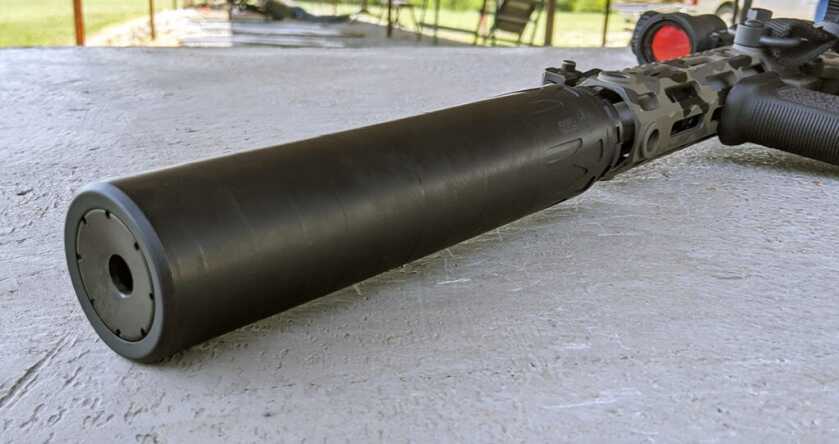
Whether you call them silencers, cans, gun mufflers, or suppressors, once you enter the wonderful world of quiet shooting, there’s no going back.
Dead Air ranks at or near the top of any list of suppressor companies. Founded by suppressor godfather Mike Pappas, Dead Air has made a name for itself constructing high-quality, super-quiet cans right here in the USA. They’ve followed the release of their popular Nomad 30 with an even quieter suppressor designed for big calibers and hard use—the Nomad L.
With the help of Fossil Pointe Sporting Grounds in Decatur, Texas, I had a chance to compare the Nomad L to three other suppressors: the Nomad 30, the Dead Air Sandman-L, and the SilencerCo Hybrid. I shot and recorded rounds from a bolt action rifle chambered in 6.5 Creedmoor, an AR-15 chambered in .308 WIN, and another AR-15 chambered in 300 Blackout.
The Nomad L consistently suppressed sound as well as or better than any of the other cans (usually better). The L isn’t the cheapest suppressor on the market, but nothing beats its performance and durability—even more expensive cans.
Specifications
Rating: Up to 300 Norma Mag: 22 HORNET, 5.56 NATO, 22-250, 204 RUGER, .243 WIN, 6.5 CREEDMOOR, 6.8 SPC, 7.62 NATO, 7MM REM MAG, .30-06 SPRINGFIELD, 300 BLACKOUT, 300 WIN, NORMA MAG, ULTRA MAG
DIRECT THREAD ONLY: 5.45X39MM, 7.62X39MM W/ CONCENTRIC BARREL, 7.62X54R W/ CONCENTRIC BARREL
Length: 8.39″
Weight: 18.3 oz.
Diameter: 1.735″
Finish: Cerakote body
Thread Pitch: 5/8×24″
Min. Barrel Length: No Restrictions
MSRP: $1,065
Design and Manufacturing
That performance starts with the design and manufacturing process. The Nomad-L is designed and manufactured in Georgia, and uses a tubeless design with 17-4 stainless steel laser-welded baffles. The end cap is constructed from Grade 5 titanium, and the rear mount is nitrided stainless steel.
The 17-4 stainless steel used for the baffles is a precipitation-hardened steel designed to provide corrosion resistance and high strength at temperatures up to 600 degrees Fahrenheit. It is full-auto rated for 5.56 NATO, but users shouldn’t feed more than five or six mags through without letting the can cool off.

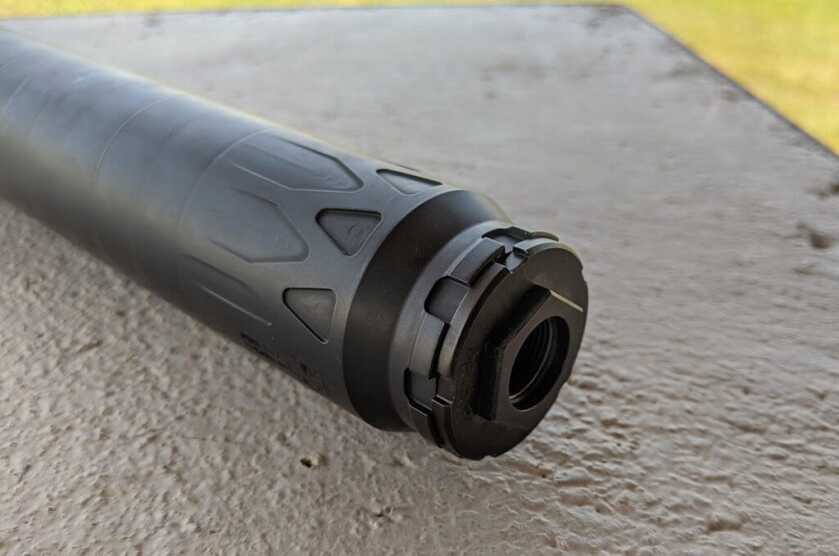
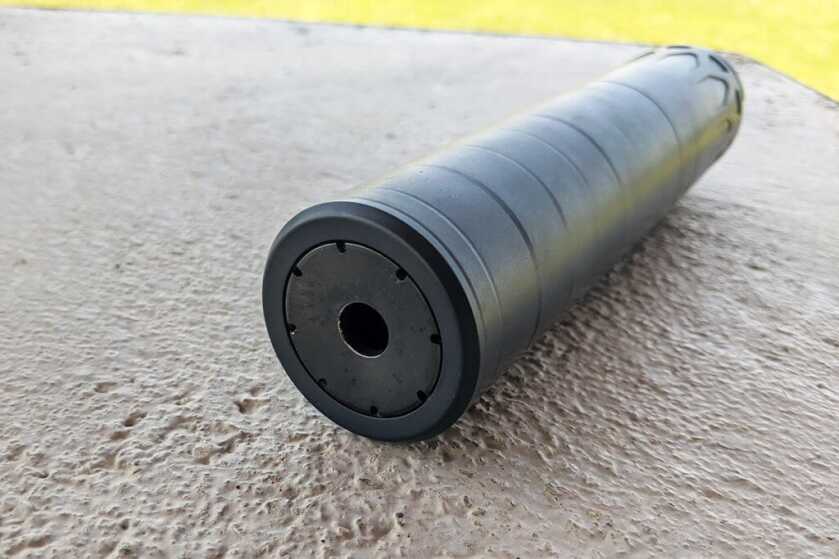
The Nomad-L can be directly threaded onto the end of a rifle with a 5/8×24″ pitch (as I did in this review) or attached using Dead Air’s KeyMo attachment system. The Nomad-L can be used with E-Brake as well, which reduces felt recoil and muzzle rise.
Plus, Dead Air puts their money where their mouth is. All Dead Air products are covered by a warranty against all manufacturing defects and damages caused by the normal use of this product. The warranty doesn’t cover things like abuse, neglect, and misuse, but they’ll replace your can for any other reason
Performance
Listening to some folks describe suppressor sounds reminds me of listening to fine wine or craft beer connoisseurs describe their favorite beverage. I can appreciate their well-trained palates, but when it comes to suppressors, I’m only interested in one thing: comfort. Does this suppressor allow me to shoot without experiencing discomfort?

It’s important to note that just because a shot report feels comfortable doesn’t mean it’s not causing hearing damage, especially over the course of an entire range session. But we don’t use suppressors because we like the sound in the same way a wine expert likes the taste of wine—we use them to protect our hearing.
That’s the standard I used when I compared the Nomad L, Nomad 30, Dead Air Sandman-L, and SilencerCo Hybrid across .308 WIN, 6.5 Creedmoor, and 300 Blackout. To help you see, hear, and visualize what I heard, I also took video of every can and caliber and threw the sounds in an audio editor to produce an audio signature.
The first thing to know about suppressor videos is that they do a poor job representing the in-person experience. Microphones are designed to bring all volumes to within a certain decibel range—they make loud sounds quieter and quiet sounds louder. That’s why I’ve included under each video a summary of the notes I took while shooting. Along with the sound charts below, I hope they’ll give you a clearer picture of the experience.
6.5 Creedmoor
There’s nothing like a quality suppressor on a bolt gun. The Nomad L on a Howa 1500 chambered in 6.5 Creedmoor was the most pleasant supersonic round I fired all day. I didn’t use a decibel meter because smart people tell me it’s doesn’t tell you whether a sound is “hearing safe” or not. But even though the Nomad L may not have been technically hearing safe, it felt that way. I experienced no discomfort in either ear, and I couldn’t discern a first-shot pop.
I wrote “hearing safe-ish” in my notes about the Nomad 30. I did experience some discomfort in my left ear, and you can actually hear a difference in the video. It wasn’t unpleasant, but not as comfortable as the L. I noticed a sharper pop while shooting the Sandman, and duller thud while shooting the Hybrid. They both produced a similar level of discomfort as the Nomad 30.
308 Win.
The Nomad L suppressed the .308 Win. more effectively than the other cans I tested. None performed poorly, to my ears, but the L produced the least discomfort. None were as comfortable as the 6.5 Creedmoor, which is due partly to the cartridge and partly to the platform.
The Nomad L produced a sharp crack, but I found the sound to be manageable for one or two rounds in succession. I’d want to wear hearing protection if I planned to shoot for an extended session, but the L would be perfect on a hunting rig when you only plan to take one or two shots.
The Nomad 30 was louder and less comfortable to shoot than the L and the Sandman. I found the Sandman to be most comparable to the L, and the Hybrid landed somewhere closer to the Nomad 30.
300 Blackout (Supersonic)
Shooting this caliber in the AR-15 SBR platform was the least comfortable of the three calibers I tested. Using suppressors was obviously a big step up from shooting unsuppressed, but even with the Nomad L, I found that my right ear rung with the report. All four suppressors were comparable, and all produced similar ear ringing.
If God had a gun to my head, I think I’d still give the nod to the L, with the Hybrid coming in second, the Sandman in third, and the Nomad 30 in fourth. But all four were so similar, that you may well get different answers from different shooters.
300 Blackout (Subsonic)
This is child’s play for any suppressor worth its salt, and all four suppressors were up to the challenge. I didn’t notice any difference among the cans tested—in all four, the action produced the loudest sound.
Sound Chart?
I’ll be the first to admit that I’m not a sound engineer (if there are any sound engineers reading, let us know your thoughts in the comments!), and the microphone I was using may not be sophisticated enough to pick up significant differences. But the patterns I see align in several ways with my impression of each can.
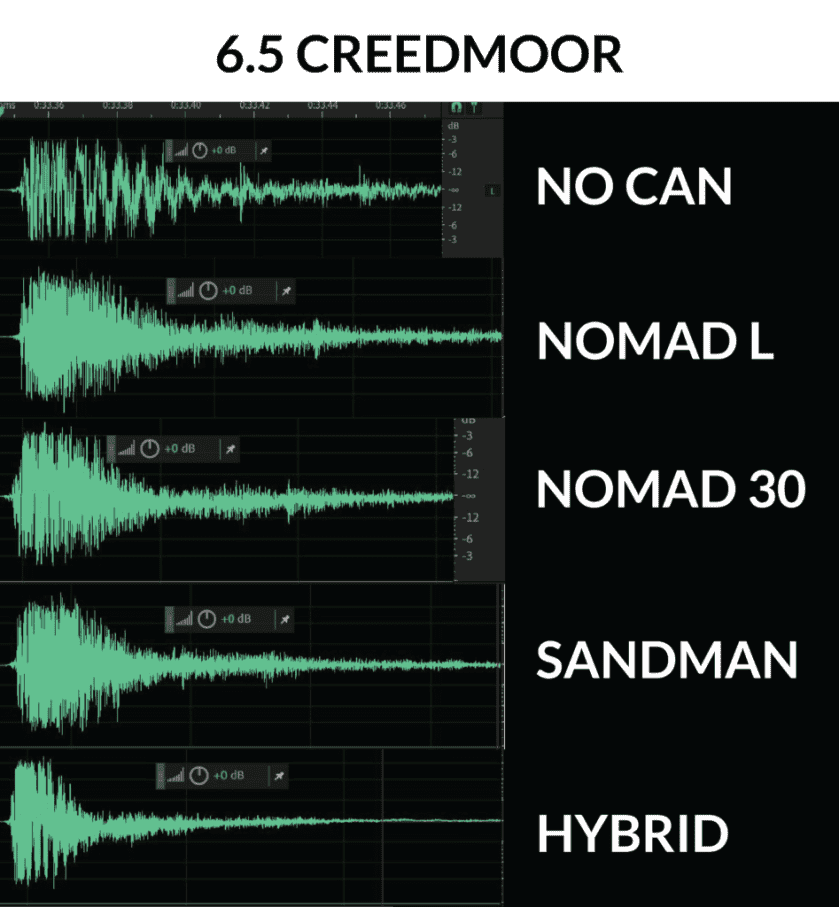
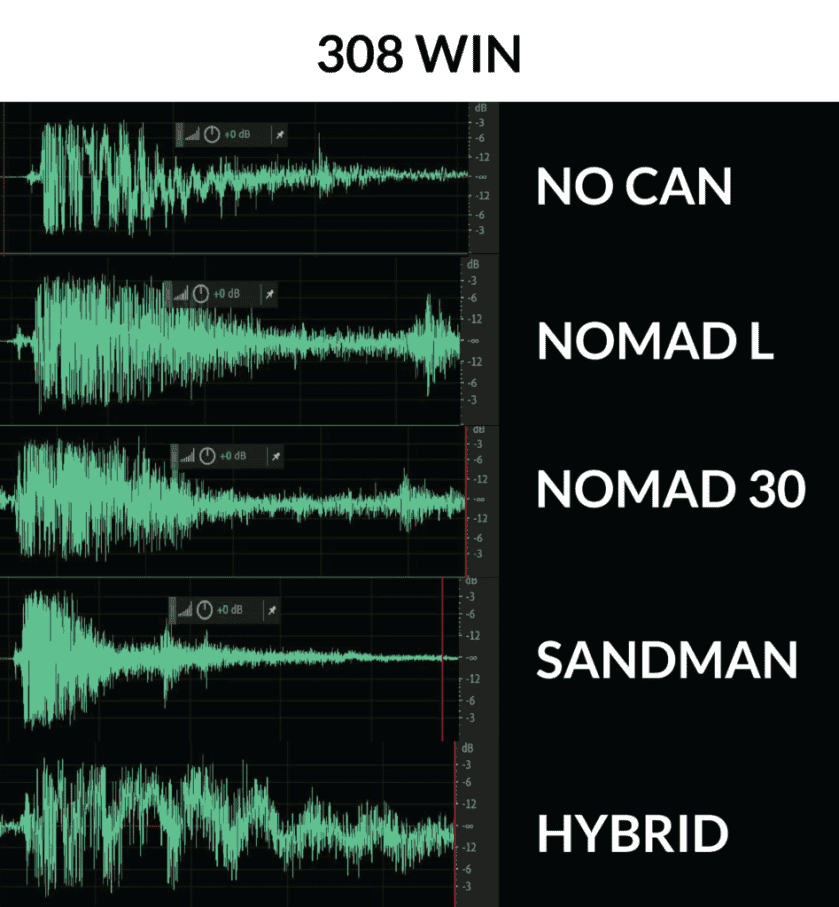

First, I couldn’t discern any differences between the cans while shooting supersonic rounds from the 300 Blackout. As I mentioned above, they were all uncomfortable to shoot, and the signature of each can is the most like the “no can” signature.
Second, the 308 Win. was also uncomfortable through each can, but the Hybrid was by far the least comfortable and the L was the most. You can see in that chart that the Hybrid signature resembles the “no can” signature more than any of the others.
Third, you can see on the 6.5 Creedmoor chart that all suppressors do a nice job modifying the “no can” signature, but the Hybrid quiets the sound more quickly than the other three. This could account for the dull thud I described above.
You can take this for what you think it’s worth. I find it interesting, but it may not mean much to someone with more technical sound training.
Conclusion
Eagle-eyed readers might point out that I didn’t test the Nomad L with a Big Boy™ cartridge. I wasn’t able to bring any magnum rifles on this trip, but I did speak with Sam Scalco. Sam works at Fossil Pointe, and he’s my go-to guy for suppressor info. Fossil Pointe supplied me with the suppressors I used for this test, and Sam is constantly shooting and testing all the most popular suppressors on the market.

He told me that they compared the Nomad L against the much more expensive Thunderbeast Ultra9 with 308 Win., 6.5 Creedmoor, and 7mm Mag. There were several people on the range that day and most couldn’t tell any difference between the two, including while shooting the 7mm Mag. Of the people who said they could tell a difference, some picked the Nomad L as quieter, and some picked the Thunderbeast Ultra 9.
You may not be familiar with Thunderbeast, but suffice it to say, anything that can stand toe-to-toe with one of their products is a winner. Plus, the Nomad-L is about $200 cheaper. Win-win.
Click here to check out the Nomad-L for yourself.

I have a question on whether threading is required or not. I watched a program showing firearms used by the military and one of the suppressors was clipped onto the barrel with no change to the barrel ie. threading. Is something like that available to the public. I often watch the “American Hero Channel” on cable and this was a program dealing with the military entering hostile buildings in Iraq and Afghanistan. Can you please provide information on this type of suppressor.
The photo shows the Hybrid with a muzzle brake. Which muzzle brake was installed on the Hybrid for testing – the 30 or 46 caliber brake? If a brake wasn’t used, which end cap?